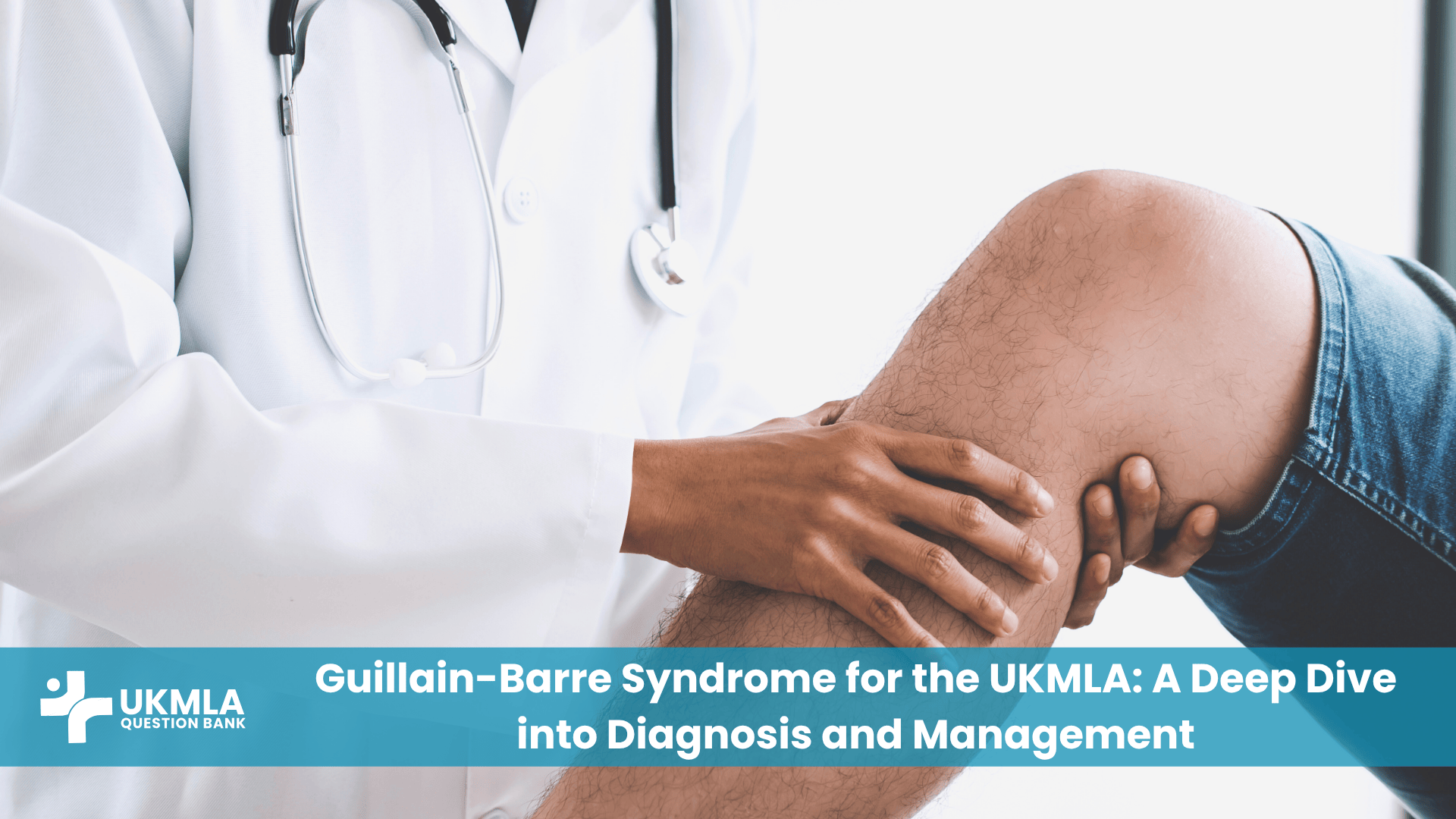Introduction
Among the neurological conditions tested in the UKMLA, Guillain-Barre Syndrome (GBS) stands out as a critical, high-yield topic. It represents a true neurological emergency where prompt recognition and management can be life-saving. For medical students, mastering GBS means understanding its classic “bottom-up” paralysis, the subtle clues in its history, and the specific findings in investigations that clinch the diagnosis. This comprehensive guide provides a deep dive into guillain barre syndrome ukmla essentials, covering everything from the underlying pathophysiology to the nuances of supportive care, ensuring you are fully prepared for any question that comes your way.
Table of Contents
ToggleThe Classic Patient: Pathophysiology and Common Triggers
To understand GBS, you must first understand how the body’s own immune system turns against itself. The story of GBS almost always begins with a preceding infection.
Molecular Mimicry: The Post-Infectious Link (Campylobacter jejuni)
GBS is a classic example of molecular mimicry. In about two-thirds of cases, patients report an infection—most commonly a diarrhoeal illness—one to three weeks before the onset of neurological symptoms. The most frequently identified trigger is the bacterium Campylobacter jejuni.
Here’s how it happens: The surface of the C. jejuni bacterium has molecules (lipooligosaccharides) that look very similar to components of the myelin sheath that insulates our peripheral nerves. The immune system produces antibodies to fight the infection, but these antibodies mistakenly cross-react and attack the myelin sheath (or sometimes the axon itself). This autoimmune attack is a crucial concept in many infectious disease essentials for the UKMLA.
An Attack on the Peripheral Nerves: Understanding Demyelination
The immune-mediated attack on the myelin sheath is called demyelination. Myelin is essential for fast nerve conduction (saltatory conduction). When it’s stripped away, nerve signals slow down dramatically or fail to transmit altogether. This failure of nerve conduction is what produces the profound weakness and paralysis seen in GBS. This is a fundamental concept in any UKMLA neurology essentials guide.
Hallmarks of GBS: Clinical Presentation
A UKMLA question will often paint a very clear picture of the GBS patient. Your job is to recognize the pattern.
Symmetrical Ascending Weakness: The “Bottom-Up” Paralysis
This is the absolute classic feature of GBS. Patients typically notice weakness starting in their feet and legs, which then progresses upwards over hours to days to involve the trunk, arms, and even the cranial nerves. This symmetrical, ascending pattern is the most important clue. Patients might describe difficulty walking, climbing stairs, or a “heavy” feeling in their legs.
Areflexia and Reduced Tone: The “Floppy” Patient
Because GBS affects the peripheral nerves (it is a lower motor neuron pathology), you will find areflexia (absent reflexes) or hyporeflexia (severely reduced reflexes) on examination. The patient’s limbs will also have reduced tone, often described as “floppy.” The combination of rapidly progressing weakness and absent reflexes is highly suggestive of GBS.
Sensory and Autonomic Dysfunction
While GBS is primarily a motor neuropathy, sensory symptoms are common. Patients often report paraesthesia (pins and needles) in their hands and feet, which may precede the weakness. Pain, often in the lower back, is also a frequent complaint.
Autonomic dysfunction can occur in severe cases and is a major cause of morbidity. This can manifest as:
Large fluctuations in blood pressure
Cardiac arrhythmias
Urinary retention
Confirming Your Suspicions: Key Investigations
While the diagnosis is often made clinically, specific investigations are required for confirmation. This is a key area for testing your ability in interpreting clinical data for the UKMLA AKT.
Lumbar Puncture: Finding Albuminocytological Dissociation in CSF
A lumbar puncture to analyze the cerebrospinal fluid (CSF) is a crucial investigation. The classic finding in GBS is albuminocytological dissociation. This hallmark term means:
High protein (albumin): The widespread inflammation and damage to nerve roots allow protein to leak into the CSF.
Normal white cell count (cytology): Despite the inflammation, there are typically very few white cells in the CSF (<10 cells/μL).
This pattern helps to distinguish GBS from infectious causes of weakness, which would typically have a very high white cell count.
Nerve Conduction Studies: Proving Demyelination
Nerve conduction studies are the most specific test for confirming GBS. These tests measure the speed and strength of electrical signals travelling through the nerves. In GBS, the studies will show evidence of demyelination, such as slowed nerve conduction velocity. While you won’t be asked to interpret raw data in the UKMLA, you should know that this is the definitive test to confirm the underlying pathophysiology.
Table 1: Key Diagnostic Features of Guillain-Barre Syndrome
| Feature | Classic Finding |
| History | Preceding infection (e.g., gastroenteritis) 1-3 weeks prior |
| Examination | Symmetrical, ascending weakness with areflexia |
| CSF Analysis | High protein, normal white cell count (albuminocytological dissociation) |
| Nerve Conduction Studies | Features of demyelination (e.g., slowed conduction) |
Management of guillain barre syndrome ukmla
GBS is a medical emergency requiring hospitalization. Management is twofold: immunomodulatory therapy to halt the autoimmune attack and intensive supportive care.
The Two Key Treatments: IVIG vs. Plasma Exchange
The goal of treatment is to remove the harmful antibodies causing the nerve damage. Two treatments have been proven equally effective:
Intravenous Immunoglobulin (IVIG): This involves a 5-day course of infusing high-dose, pooled antibodies from healthy donors. It’s believed to work by neutralizing the harmful antibodies and dampening the immune response. It is generally the first-line choice due to its ease of administration.
Plasma Exchange (Plasmapheresis): This procedure involves removing the patient’s blood, separating the plasma (which contains the harmful antibodies), and returning the blood cells with a plasma substitute. It is equally effective but more invasive and requires specialist equipment.
Why Steroids Do Not Work
This is a crucial and frequently tested point. Unlike many other autoimmune and inflammatory neurological conditions (like multiple sclerosis), steroids have been shown to be ineffective in GBS and should not be used.
Supportive Care: The Critical Role of Respiratory Monitoring (FVC)
The most life-threatening complication of GBS is respiratory failure due to paralysis of the diaphragm and intercostal muscles. This makes supportive care the cornerstone of management, a key topic in UKMLA emergency medicine essentials.
Clinical Priority: All patients with GBS must have their respiratory function closely monitored with regular measurements of Forced Vital Capacity (FVC). A declining FVC is an indication for elective intubation and ventilation before the patient becomes exhausted and arrests.
Prognosis and Recovery
While GBS can be devastating, the prognosis is generally good with modern medical care. The weakness typically peaks within four weeks. Recovery then begins, but it can be a slow process, often taking months or even years. Around 80% of patients make a good recovery and can walk independently, but many are left with residual symptoms like fatigue or neuropathic pain. Authoritative sources like the NHS and the NINDS provide excellent overviews of the condition.
Frequently Asked Questions (FAQ) about Guillain-Barre Syndrome for UKMLA
Miller Fisher Syndrome (MFS) is a rare variant of GBS. Instead of the classic ascending paralysis, its hallmark triad is ophthalmoplegia (paralysis of eye muscles), ataxia (coordination problems), and areflexia. It is associated with a specific antibody (anti-GQ1b).
The progression is typically rapid, evolving over hours to days. By definition, it peaks by four weeks from onset.
It is exclusively a disease of the peripheral nervous system (PNS). The brain and spinal cord (the CNS) are not affected.
Forced Vital Capacity (FVC) to monitor for impending respiratory failure.
Profound paralysis leads to immobility, which is a major risk factor for DVT. All GBS patients require DVT prophylaxis (e.g., low molecular weight heparin).
Recurrence is rare but can happen in a small percentage of patients.
Yes. Cranial nerve involvement is common, and about 50% of patients develop bilateral facial weakness (facial diplegia).
There is no “cure” in the sense of a drug that stops the disease instantly. The treatments (IVIG, plasma exchange) speed up recovery by removing harmful antibodies, but the body still needs time to repair the nerve damage.
Urgent referral to a hospital for neurological assessment and admission. This is a condition that must be managed in a hospital setting.
The key features of GBS are the symmetrical, ascending nature of the paralysis, the areflexia, and the preceding infectious illness. This pattern is highly specific.
Conclusion
Guillain-Barre Syndrome is a quintessential UKMLA neurology topic that tests your ability to recognize a clinical pattern, recall key investigations, and prioritize life-saving supportive care. By understanding the link to preceding infections, memorizing the classic presentation of ascending areflexic paralysis, and knowing the hallmark CSF finding of albuminocytological dissociation, you will be well-equipped to handle this neurological emergency. Most importantly, never forget to monitor the patient’s breathing—it’s the key to safe management and a core principle of good medical practice.




